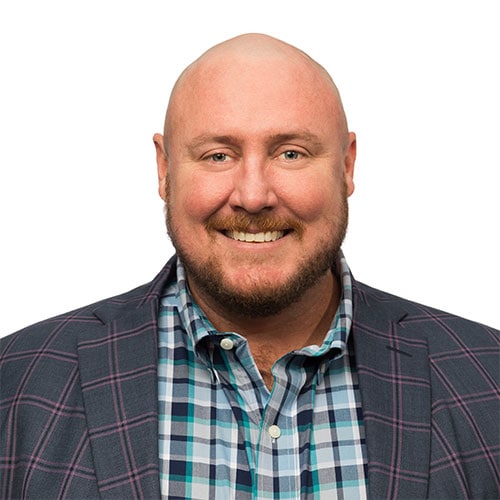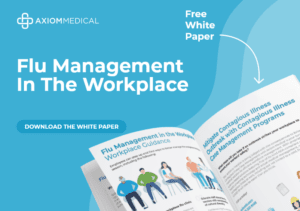[00:16] – Holly Foxworth
Hello and welcome to the Axiom webinar follow-up. My name is Holly Foxworth. I’m a registered nurse and the marketing manager for content here at Axiom Medical and we’re thrilled to have you join us today. Unfortunately, Chuck Cable, who had been with us last week for the initial webinar, he’s traveling this week so he’s not going to be joining us. But we do have the dream team back. And so we’ve got the Chief Medical Officer, Dr.Scott Cherry, and also Chief Marketing Officer, Dara Wheeler, who are going to take your questions for all things vaccines. Before we jump over and introduce them, they’ll introduce themselves. But I did want to quickly mention we have actually a new webinar series that’s going to be starting this next week. It’ll be on Thursday at 1:00 p.m. Central and the name of that is the Lasting Effects of Lockdown. So now here we are, nearly a year, actually, I think it’s been a little bit over a year that we’ve really been looking at the specific symptoms for COVID-19, looking at how it is that we can mitigate the transmission within our workplaces, etc.
But one of the pieces that we haven’t really realized in and seen the full effect of is the things that come along with that. So we’re going to be jumping into everything from the COVID long haulers, where you’re seeing that they have extended terms of symptoms that are there. It definitely affects some of their physical capabilities. So we’re going to be looking at how it is that you can really assess that, how you can look at that physicality and see if they’re really able to perform at the same levels that they had before, to be able to determine if it’s going to be a safe environment for them. We’re also going to be looking at the effects that have occurred with isolation and so the depression things that come along with that as well. So we’re really excited. It’s going to be a great series. We have an excellent guest lineup of experts that share some of the best practices and we’re really thrilled about this series. So if you haven’t already, please make sure that you sign up. We do have some emails that have already gone out with the instructions for how you can sign up for that webinar series.
[02:08] – Holly Foxworth
We also had that listed on our social channel. So either way, you’re welcome to join. Just sign up and we’ll get you fixed up there. So at this point, I’m going to go ahead and turn it over and let both Dara and Dr. Cherry introduce themselves and then we’ll get started with the questions. Dr. Cherry, do you want to go first?
[02:24] – Dr. Cherry
Yes. Good afternoon, everyone. I’m Scott Cherry. I’m a preventive medicine and occupational medicine physician. I’ve been supporting corporate, military and industrial operations for the past 15 years. And we’ve been living COVID for the past year now at least. And it’s a pleasure to be with you.
[02:43] – Holly Foxworth
Thank you. And Dara?
[02:45] – Dara Wheeler
Yeah. Thanks for having me, Holly. I am Dara Wheeler, I’m Maxime’s Chief Marketing Officer. I’ve been with Axiom for about fifteen years and Dr. Cherry and I are excited to follow up on these questions that we got last week. We got some really good engagement from all of you. So thank you for the questions and we’ll get some answers go on here shortly.
[03:05] – Holly Foxworth
Absolutely. Great job. All right. Well, we’ll go ahead and just jump into them because we actually had quite a few that had come up from this last webinar. But the first one actually was from Daniel. And he was asking whether a personal concern about the vaccine being new, whether that would be legitimate for a reason to not get vaccinated, if you determined that it was going to be a mandatory vaccination status, as if the employer required that?
[03:32] – Dr. Cherry
Yeah, I think that’s a good question. And probably on most people’s minds is the newness of a vaccine. I don’t think we’ve really had to kind of assess such a broadly applicable new technology or a new vaccine in our lifetimes, mostly, maybe some in the military. But yeah, I think this is where, you know, one of our tenants of having a relationship with your personal doc is key, where you can discuss your individual factors of risk because there are different levels of risk from COVID based on well-defined vulnerable populations. And then also talking with your doc that you’ve developed a rapport about their perspective on the efficacy. So how well the vaccine works and then the safety profile. For most of the vaccines here in the US, they’ve received the Emergency Use Authorization by the FDA, which the FDA’s job is to approve safe and effective therapeutics. But again, I think everyone has a very nuanced position based on their risk profile for themselves, their family, their company. And so that’s kind of my perspective, is to really discuss that. Now there are multiple vaccines available on the market, too. So we’re starting to see some concerns about safety, which may or may not be ultimately proven out, but having that personal discussion is key, I think.
[05:22] – Holly Foxworth
Yeah, definitely. You know, the other piece of that too that we seem to get a lot is we’re seeing a little bit of a change, it seems like, in the anxiety levels about getting the vaccines. You know, whenever that first started, it seemed like nobody really knew we had a significant part of the population that was saying, you know, we will not get the vaccine. But now it looks like we’re having a little bit more interest in that. Do you think it could be an anxiety issue as well? And maybe if you did a little bit more education on that end with employees, that could help that as well doctor?
[05:51] – Dr. Cherry
You know, I agree with your statement there. What resonates with me is it may be a personality driven phenomenon. So, you know, there are five main personality traits. One of them is openness to new ideas or creativity. Some of us are more predispositioned to being early adopters, with technology, with all kinds of things, and then some of us are middle of the road and some of us are late adopters. So I think there’s going to be a normal distribution of those personality traits in the population. And I think that’s going to manifest the same way people would get vaccines. So I do think over time, just the way there’s so much information being generated about COVID in general, like, for instance, the blood clotting issue with AstraZeneca. To be determined if it’s truly a causative factor or not, but that will also add to the anxiety and affect, I think the whole population in general. So I agree with what you said, Holly.
[07:10] – Holly Foxworth
Good points. Yeah, it’s a lot to think about. Dara, did you have anything you wanted to add to that?
[07:15] – Dara Wheeler
Yeah, I agree. What I am seeing, at least with our client partners and what I’m hearing is that there is a bigger uptick in people opting in into taking the vaccine than we thought initially. And I think the points about education, I also think what we’re seeing is that more and more people know people that are getting the vaccine. So the comfort level is starting to spread a little bit because we all have known people that have completed a series and listen to their side effects and how they’ve dealt with it. And so I think that humans in general, we’re definitely more comfortable seeing or adopting something once we’ve seen somebody else adopt it. And so I do think that spreading the comfort level around a little bit as well.
[07:57] – Holly Foxworth
Absolutely. Good point. All right. Let’s see, Keith was the next question. He was asking what the threshold would be for achieving herd immunity. So he was asking what levels that they would need to maybe reach before they could do things like discontinue some of the mandated mask rules that are there within their workplaces.
[08:17] – Dr. Cherry
Yes, so herd immunity is this principle that if the majority of people are immune, then they provide this herd protective effect for those that are not immune. So I think the picture or the analogy of this is in the jungle or in the wild, if you have a bunch of zebras together, they’re much more defensible to a predator. And so the most vulnerable, if they’re in the middle of the herd, are going to be more protected than by themselves. So in general, I think herd immunity for most infectious diseases range from like 50 to 80 percent, depending on the infectiousness of the disease. And I think estimates for COVID before the variants were probably around 70 to 80 percent. The variants are going to probably make this foggier. And so it’s probably to be determined. But some of the variants are potentially more infectious because there’s data that shows those that are infected may have higher viral loads, and so potentially when they’re symptomatic, are going to generate more infectious particles to others. So theoretically, they’re going to be more infectious. So I think it’s going to be still – the majority is going to need to be immune, so to speak.
[09:49] – Holly Foxworth
And do you want to speak maybe a little bit about the mask mandate? I know that it’s kind of been a hot discussion here in Texas. Obviously, we had our governor that removed some of those mandates that we were seeing and that’s occurred in other states as well. But we do see that the employers are still enforcing their own safety in the organization. Is that what you anticipate will continue?
[10:10] – Dr. Cherry
Well, maybe what I’ll discuss is the CDC recently published their own internal study of mask effectiveness across states that decided to “shut down”, compared to those that did not. And they came to the conclusion that there was ultimately about a one percent difference in infection rates between states that did and did not shut down. And so obviously, there’s a lot of confounders and this study is not fully controlled for confounders, but the results they found were statistically significant, meaning there was a difference beyond randomness between the two groups or the control and the experimental group. And so I think, you know, like Texas decided to lift the requirement from the state level, but allowed businesses and the individual to decide. So I think every state is probably going to need to weigh that level of evidence from this one study and other studies and put it to their own risk tolerance for infections and waiting to see how much this evidence – how much credibility they’re going to apply to it and go from there. I think we’ve seen other studies, too, that I think Dr. Fauci had kind of re-addressed for schools where they’re actually moving forward with some shift from the six-foot contact tracing distance to three feet for children with face masks on. So, you know, when I look at it that way, it’s probably if you’re looking to open up more schools in a more densely fashioned approach, you know, masks probably make more sense in general just because it’s a high-density population. So there’s a lot of competing factors out there. I’m not an expert in childhood education, but from a preventive medicine and population health approach perspective, education is probably one of the most important things in the social implications for our children. I think that should be prioritized even if it comes along with some of these other requirements. So it’s very difficult, so to speak. Dara, did you have any other thoughts on this? I know you’re on the forefront of this as well.
[12:58] – Dara Wheeler
No, I think you answered that really well. I do think that locally in Texas whether an employer decides to continue with the mask requirements or not, it is causing a lot of friction in the community. And I think that leaving businesses to decide is fine. But then the enforcement of that ends up being left to people that may not feel all that comfortable enforcing it. And I agree with your weighing on the schools. I think it’s going to be really interesting to see how this progresses. I do feel that, you know, what I’m seeing as I talk to people and what I’m hearing, people are feeling a little bit relieved. There is some positivity out there with the changes we’ve seen and positivity rates over the last few weeks. But again, I think, like you said, there’s some caution that needs to be involved in that as well, because although we’ve got some positive news, we do need to be very cautious as we progress through this so that we don’t have major outbreaks occurring again.
[14:05] – Holly Foxworth
Absolutely. Dara I was going to ask you about – we had discussed your travel before we started this but I was going to ask your thoughts. So how was that? Whenever you and your family were in the airport, did it seem like that everybody was still compliant with those mandates of wearing masks and continued to do so as protective measures that were there? Or are they noticing that they’ve kind of decreased to a degree?
[14:27] – Dara Wheeler
No, I think I still, in public spaces, still saw quite a few people following or everybody really following the rules. The airlines were very, very careful about following mask rules and making sure that everybody was masked up. The only exception was if you were taking a sip of liquid or eating. But the airports and the planes were packed. And I was telling Holly and Dr. Cherry before the call that it was very interesting because I do think that spring break has opened up and the country has opened up a little bit and we feel, like I said, feeling very positive. And there’s lots of good news on the horizon with the vaccines. And I think everybody wanted to feel like they could travel again and head out. I think it’s early days and we’ll see what happens post-spring break if we have another spike. But it was very, very busy at the airports and on the airlines and on the airplanes. So we’ll have to kind of sit and watch and see what kind of positivity rates we see in the community after the spring break.
[15:31] – Dr. Cherry
You know, just a tidbit. I think you brought up air flight and, you know, in a lot of ways that seems to be fairly risky, at least at first glance. But I’ve come across some experts talking about how there’s actually been a low infection rate or outbreaks amongst plane passengers. And you know, something from industrial hygiene we used to deal with or I used to deal with in a previous role was indoor air quality. And one of the main factors is the air exchange rate of the rooms. And so you want a certain amount, which I kind of forget now what rate that is, whether it’s three times per hour or 10 times per hour, 20 times per hour, it’s off my radar right now. But something that planes do really well is having huge air exchange rates that go through the high-efficiency particulate filters. So I think it’s an interesting observation where I think, again, at first glance you would feel like airplane travel would be a high-risk endeavor, but it appears to be low risk. If anything, it’s just to encourage my colleague not to worry when she gets on a plane too much. But it is something interesting to discuss, you know.
[17:01] – Dara Wheeler
Yeah, it’s interesting. And also, you know, I’ve talked to a lot of parents and talked a lot about the way that children get infected with COVID, which is very different from the way adults get infected. And one of my friends has two young ones, and she talked to her pediatrician about traveling in an airplane with children and she said the same thing. She said, We’ve seen almost no evidence that there’s been community spread from an air flight, especially in children. But it kind of goes back to what Dr. Cherry said before. It is your personal risk tolerance. And again, we happen to work for a company that does this day to day out. So I have the luxury and the ability to test before, to test during my travel, to test after my travel and be very careful about coming to visit family and not spread a bunch of disease around the people I’m visiting. But it feels very risky. But I actually think, you know, we traveled, everybody’s heard my story or a lot of people have heard my story last summer where we traveled across the country in a car and RV. And while you’re contained within a vehicle and you feel pretty comfortable there, every stop you make you’re potentially exposing yourself at every gas station and every place you stop to get food instead of at least with a flight. Even though it feels risky to be in this plane with this many people, it’s a very short window of time. And overall, you’re exposing yourself or kind of putting yourself at risk for two, three hours. And at the airport, you can find ways to mitigate that risk, too. But when you’re in a car, although you’re self-contained, every time you stop, you’re basically upping that risk again. And you can do things to mitigate that but you have to be very careful to be thoughtful about making sure you’re using hand sanitizer, making sure you’re washing your hands. And when you’re traveling with children, that’s always a fun endeavor to just spray them down with hand sanitizer at every opportunity.
[19:08] – Holly Foxworth
Yeah, that’s a game-changer with the kids for sure. Yeah. All right. Let’s see. So Raymond was the next one that was asking “Can you explain what type of fraud is occurring with the vaccines and how is Axiom able to verify the cards submitted by employees are legitimate? Dara, do you want to take this one?
[19:26] – Dara Wheeler
Yeah, I’d be happy to. So we’re starting to see fraudulent activity with vaccine cards. And the reason why we’re starting to see that, some employers have asked me why. It’s because we’re starting to incentivize being a status of vaccinated. So the CDC and their releases and employers, we’re starting to see some major incentives to having a current vaccine status with COVID. And so we’ve seen fraudulent activity on eBay and other websites where you can purchase vaccine cards. And what we’ve been doing to mitigate that is we’ve got the ability to verify via different databases. There’s going to be some consolidated databases across the US where all providers can submit their information and then we as a provider can verify that a vaccination is legitimate. Sorry, there’s a plane heading overhead. Speaking of travel and planes, and so we’re doing that. We’re also verifying if we’re running programs for clients, we’re making sure that the vaccine card or the lab report are legitimate and that we’re matching that up to the dates and that everything is in good order. And this is what we do for most of our programs that we’ve run for years and years. It’s that quality assurance component of the program to make sure that whether it’s a duty exam or whether it’s a COVID vaccine, that an employee is receiving the right exam or vaccine and that we can verify all that information for employers.
[20:57] – Holly Foxworth
Awesome. And then a lot that’s being tracked through the app that we have as well. The check-in work app.
[21:03] – Dara Wheeler
Yeah, we’re using and checking the work and we’re releasing a vaccine feature and we’ve built out an entire vaccine component of our internal system. We’re going to automate it as much as possible with those various databases. But in the meantime, there will be some manual checking that we’re doing. We envision the feature on the app being something almost like what we’re hearing with like a vaccine passport or something like that, because as travel’s opening up and there are some countries and some locations that are asking for vaccine status, employees will be able to use the app to show their vaccine status and their documentation.
[21:40] – Holly Foxworth
That’s fantastic, that is so fantastic. Ok, so the next one that we have is from Lauren and she was asking about the vaccine data. What type of vaccine should they be evaluating when making decisions about whether it’s appropriate to go ahead and return to the office, or whether that would be a safe decision.
[22:07] – Dr. Cherry
I think the reason why we’re so focused on COVID, especially early on from Wuhan, China, was this idea of severe disease. And why are so many people getting hospitalized with this novel coronavirus? So the vaccines are very efficacious at preventing severe disease. That is really the primary outcome that they’re being tracked for. As I think back on how COVID has influenced our country and some of the decisions to shut down, obviously it’s to support the hospital infrastructure, to not be overwhelmed. But I also feel that infections were also driving that to a degree. So I think the main outcome businesses should be focusing on is infection prevention. So that could be even carrier status, asymptomatic infections. That’s probably the most powerful piece of data or metric to be followed as we get more information on this, because that’s what’s really going to allow businesses to decide when to fully open or not. I think we’ve seen some state OSHAs that have some pretty low threshold on just infections that would require businesses to actually test their whole workforce weekly and potentially would even cause a shutdown at a certain threshold. But I think I’ve seen it as low as three infections in the population that are not normalized or attributed to the population. So if you have three infections out of 10 or three infections out of a thousand, that cut off it’s an absolute cut off. It’s not a relative cut off. So especially if you’re in a state that has these types of policies in place, you want to be trending on infection prevention, not just severe disease prevention.
[24:15] – Holly Foxworth
Ok. All right. The next one, let’s see, Tamie was next. This is a good one. I’ve had somebody else that was asking about this as well. Ok, so Tammy wants to know if the vaccine is voluntary, can we identify employees that have been vaccinated with a sticker on the employee badge or would that violate personal health information?
[24:38] – Dr. Cherry
Yeah, when you say it’s a good one, I think it’s a tough one. I think that this really needs to be a kind of a multidisciplinary decision at every organization like H.R. legal and medical. So the caveat here is voluntary. So if it’s voluntary, I can’t speak for the whole team, but like for Chuck he’s not here, well Chuck is both legal and H.R. for us. But, you know, when I’ve worked at other organizations where you have kind of a team approach to this, my gut would be they would not probably approve this kind of visible declaration of vaccination or not. I think it’s in a lot of ways a great message that people are getting vaccinated. But you also have to think the opposite. For those who have decided not to get it for a host of reasons, they may end up feeling some negativity organizationally or individually. And so I do think you really want to have the full team at the table making this decision and making the right one for your respective organization.
[26:06] – Dara Wheeler
I agree. And I do think Chuck did talk a little bit about this. Can you hear me?
[00:26:13.740] – Dr. Cherry
I can.
[00:26:14.680] – Dara Wheeler
Ok. I was going to say that we did talk a little bit about this last week with Chuck. And I think it goes to what Dr. Cherry said as well, that organizations need to think now about the longer term aspects of infection control in the workplace and infectious disease in the workplace. And so when you think about voluntary or mandatory programs for vaccinations, that’s part of that approach. And it does need to be multidisciplinary. Like Dr. Cherry said, you need to have medical, legal H.R. and everybody involved in how the organization will think about vaccinations long term so that as you are rolling out vaccination programs today, you’ve got that foresight into what’s going to happen next and how, as an organization, you’re going to approach vaccines and then that would dictate a lot of what would come next. But I agree with Dr. Cherry, my take would be that likely a visual representation of vaccine status probably won’t occur, whether it’s a mandatory or voluntary program, because even in a mandatory program, you’re going to have people that can’t for various exceptions or ADA accommodations. So you don’t want to visually discriminate against somebody in the workplace.
[27:23] – Holly Foxworth
Absolutely. Ok, let’s see. Joseph had the next one that was asking, How do we provide support for employees who are U.S. Citizens but working abroad and not eligible or allowed to receive the vaccine in their host country?
[27:39] – Dr. Cherry
This is another good one. You would say, right, Holly? Some of my experience in the past was if you’re part of a large organization that has an internal medical department, you may have international medical resources that can support you and that’s not probably the typical case, but potentially maybe partnering with organizations that do have expatriates and international roles that may be some partnerships where you can have kind of this partnership that allows for many U.S. Expatriates to get services in a shared services agreement because it may make it easier for them or better business case to do it. Obviously, if you’re an expatriate, you come back home at a certain time frame, whether it’s three, six months, a year or longer, but maybe just making sure people have access when they come home for those visits. And then I think lastly, my thoughts on this would be to have discussions with host countries where you have operations to see if the host country can help support through their public health infrastructure or government hospitals. Sometimes international occ med is harder, but then sometimes it’s actually much easier. They have some very interesting roles that I think sometimes make it easier. So those are my thoughts. I don’t know if Dara, you had any other thoughts?
[29:33] – Dara Wheeler
No, I agree, I mean, I don’t know that I have any enough details. It would have to be if we knew specific countries or specific resources, we could probably help guide. But I agree, there are a lot of really great international occupational health resources. And so if anybody needs pointing in that direction, we can always point people in the right direction and we can go from there. But yeah, it’s hard to get into specifics without knowing the host country for sure.
[29:57] – Holly Foxworth
All right, let’s see. Joel had the next one and he was asking if we implement a vaccine incentive plan, how should we identify and manage employees who do not want to take the vaccine for religious or medical reasons? This kind of fits in with what you referred to earlier, Dara.
[30:14] – Dara Wheeler
Yeah, I’m not sure you want to take that one first or you want me to.
[30:18] – Dr. Cherry
You go ahead, please.
[30:21] – Dara Wheeler
I think this really goes back to I think what Dr. Cherry said before, when you’re implementing a plan or you’re incentivizing vaccines, you need to work very closely with legal H.R. and your medical teams to implement a program that will be handled appropriately, because you do need to consider that if somebody can’t get the vaccine for whatever reason, whether it’s an exception, for religious reasons or other types of exceptions, you don’t want to discriminate against your employee population by not offering a similar incentive to those individuals as well. But a lot of organizations are trying to incentivize vaccines because of various reasons, including community support and with just improving their infectious disease in their workplace. So there’s a lot of really positive benefits to incentivizing. But as a team, you do need to come up with a plan that doesn’t discriminate against employees that can’t get it for whatever reason.
[31:20] – Holly Foxworth
Great answer. Dr. Cherry?
[31:23] – Dr. Cherry
Yeah, maybe the only thing I’ll add is we have the Americans with Disabilities Act and the Equal Opportunity Commission, and so there are protected classes by law. So age over 40, race, religion and then medical disability. But then there’s also kind of this general clause, very similar to the OSHA general clause that says even if you do not have a disability, if your employer regards you as having a disability, which I had to think through that years ago. An employee may not have a disability, but if they are regarded as having a disability and a negative personal action is created or maybe even a hostile work environment, then there potentially is grounds for that kind of action under the EEOC. And so because the vaccine may be maybe indicated or I think the opposite is true, if a vaccine is contraindicated into someone because of a medical condition that makes them at high risk for getting the vaccine, then if an employer’s policy basically has an incentive to get it, those who are contraindicated under a protected status can’t get it.If they are not getting that same access to that benefit, then I think there is a potential cause. And again, that’s me working very closely with H.R. and legal over years. So I’m sure an attorney or H.R. person would address it more appropriately. But I wanted to at least give that piece to it as well.
[33:12] – Holly Foxworth
Good points, yeah. All right, two more, we’ve got Dawn with the next one that was asking, How often will we have to take the COVID-19 vaccine? Will that be on a yearly basis? And then also, what about boosters for new strains of the COVID-19?
[33:28] – Dr. Cherry
I think that’s to be determined. I think the hope is that it’s just one time and we’re still getting data on how long the current COVID vaccines are good against the non-variant original COVID-19. So we need to get data to see if it’s good for at least a year or multiple years. And then we need to see how the vaccines address the variants. So I would say right now it’s to be determined, but all that is probably on the table as possibilities.
[00:34:05.400] – Holly Foxworth
Ok. All right. And then the final question then was from Ely and we see it was who? Let’s see. Would it be appropriate to stop conducting the pre-shift temperature readings for staff?
[34:28] – Dr. Cherry
I still really like the idea of pre-shift temperature readings. I probably need to look at data on determining effectiveness now that six months to a year have passed with probably some good case studies from clients and things like that. But my gut is that it’s non-invasive, especially if you have a systematic approach to temperature screening. It’s probably low invasiveness, but may still catch someone who’s feverish. And so they may be feverish because of COVID, but they might be feverish for all the other reasons from an infectious disease perspective. So my kind of personal opinion on it, you know, personal, professional opinion is I still like the idea of it. I think as you do it, more hands-on with a person actually taking temperatures broadly, not in a special populations role, it’s probably a more nuanced business case to do it or not. Dara, did you have any thoughts on pre-shift temperature readings? I know you might have gone out for a second there, but I didn’t know if you were able to catch on to our previous discussion on this.
[35:58] – Dara Wheeler
Yeah, I’m sorry. My Internet isn’t the most stable right now. But no, I only heard the last tail end of that comment. But from what I’m hearing in the market and what I’m hearing from clients, they’re not stopping doing this anytime soon. I think there’s some optimism, again, that we may see some end in sight for some of these processes. But I also think that from what I’m hearing from most, they’re going to keep these processes in place for the foreseeable future. And I don’t see them stopping in 2021 just until we learn more and understand more about where we are with this disease
[36:36] – Holly Foxworth
For sure. Yeah. Well, guys, this is excellent information before we wrap up, any closing remarks that you want to share?
[36:45] – Dr. Cherry
You know, I would just say thanks for your continued attention on this, it continues to be kind of a long-term focus with COVID and now maybe more broadly infection prevention in the workplace. So I applaud your efforts. And again, thanks for your energies on this.
[37:08] – Dara Wheeler
Yeah, I agree. Thank you all for your continued engagement and continue to reach out if you have questions or concerns or if you need support as you navigate your way through what is always a bit of a difficult situation.
[37:22] – Holly Foxworth
Awesome. All right. Well, thank you both again. Just to kind of reiterate one more time, in the event that you have questions that are specific to the vaccine about how it is that you can implement a program at your organization, we do have the White Paper guide that you’re welcome to check out. You can download that for free on our website. It’s called the COVID-19 Vaccine Guide for Employers. And we also have the new series that’s going to be starting this next week with the lasting effects of lockdown. So that’s going to be starting next Thursday, 1:00 p.m. Central. And we hope to see you there. If you haven’t already, please make sure that you stop by and register even by the emails that we sent out. Or you can also access the information from our social channels. So you can also submit your questions there in advance to coronavirus@axiomllc.com. So should you have any other questions or if we can help you with anything, don’t hesitate to reach out. Thank you.










